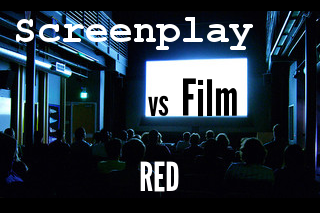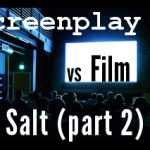Today’s Screenplay vs Film selection is RED, the movie that proved that older people still go to the movies. Jon & Erich Hoeber wrote the screenplay which follows a group of retired CIA operatives, led by Bruce Willis, who band together to discover who is hellbent on killing them. Here is a link to the RED screenplay. You should definitely read it because it’s seriously AWESOME.
So awesome in fact that there’s very few differences between that screenplay draft, dated 2008, and the final movie that was released in 2010. However there still are a few differences, and while they’re mostly minor, they still yield some good screenwriting tips (and screenwriting rants), which I’ll get to in a minute. I was so impressed by this screenplay, particularly by the way they balanced humor and action, that I did some research on its authors and came across an interview with Erich over at Done Deal Pro. Here some of his screenwriting advice:
I think the best way to learn screenwriting is to read good screenplays and see good films. Here in a LA, there are plenty of opportunities to do both…
Screenplays are often undisciplined. They’re not written to be shot, but written for readers and studio executives, and they tend to be friendly and bouncy and have a lot of capitalization. The most important thing to do as a screenwriter is to figure out what story you’re telling and make certain everything in the script supports that story. Jon and I often get the criticism that our style is too stark. But it’s something we aspire to. Everything in the script that isn’t helping us is probably hurting. We try to have as much respect for the reader as possible.
One final note: RED is actually based on a comic book. I’ve never read it, but from the comments on Amazon, I gather that the comic only featured Bruce Willis’s character–not any of the other retired CIA operatives played by John Malkovich, Helen Mirren, and Morgan Freeman. Not only did this brotherly screenwriting team seamlessly integrate these new characters, but they also integrated all of the humor with the action. Apparently, the original comic is much more serious and stark in tone, focusing on the psychological ramifications of a man who’s killed others as a living.
So Marvin’s decoy home, his standoff with the realtor and the rest of those wonderful comedy moments–all the Hoeber brothers. I think the movie did a fantastic job of combining humor and action.
Screenwriting Tip #1: Don’t sacrifice your character for the sake of the plot
In RED, Bruce Willis’s character, Frank Moses is a retired CIA operative who has fallen hard for the lady who administers his pension checks, a feisty little lass named Sarah (played by Mary Louise Parker who first wowed me on The West Wing). Frank knows that the CIA will have no qualms killing her to get to him, so when he goes on the run, she has to go to.
Keep in mind that Sara has never seen Frank before. They’ve only talked on the phone, so when he shows up suddenly in her apartment, she’s scared and resists going with him even when he explains that her life is in danger. Very understandable. In the original screenplay draft, however, she didn’t resist enough. She yells “stand back,” asks “what’re you doing here?” and uses the Lord’s name in vain. That’s about it. Oh, she also observes that he’s taken time to do the dishes (which is a wonderful subtly comic moment).
In the movie, they spiced up her resistance a little bit, and she got into a minor (very minor) fisticuffs with Frank, using a chandelier as a weapon. She also yells “HELP!” hoping her neighbors would hear her–a basic reaction conspicuously absent in the screenplay. You’re probably thinking it’s a very small difference. And you’re right, it is. But that small change creates a HUGE difference in the perception of Sarah’s character. In the screenplay, it seemed like she was only offering token resistance. But the addition of the chandelier action makes her more realistic and is in keeping with her feisty character.
Now, I should admit that the Hoeber brothers didn’t sacrifice Sarah’s character completely in either their screenplay or in the movie. In both, after Sarah resists going with Frank, we see them taking a road trip. Frank is driving while Sarah is in the back, her mouth covered with duct tape. It’s no cozy ride–which would have been a complete sacrifice of her character. The reason I’m bringing this issue up and making it screenwriting tip #1 no less is because this happens so much in amateur screenplays. What could be a really great character is sacrificed on the altar of plot.
So when you’re writing your own screenplay, and your characters have to do X in order to advance the plot, make sure that their motivations and reactions still ring true. If your characters would never do activity X (and may have even voiced strong objections to doing X throughout your screenplay), don’t have them cave and engage in X because your plot requires it. Give them a strong reason or motivation for this sudden switch.
Screenwriting Tip #2: Don’t rely too heavily on technology
If you’ve seen the movie, then you’ll probably agree with me: one of the most memorable characters is the Old Record Keeper. Even though he never wielded a gun or did anything violent, he seemed like a badass. That actor, Ernest Borgnine, brought a lot to the few lines that he had.
The Record Keeper had important information to share with the characters and also with us, the audience. Whenever you need to distribute information in your screenplay, try to do it with a living, breathing human–not an email, not a text message, a memory stick, or a tweet. Why?
Because digital information can’t bring to the screen the qualities that an actor can. The Record Keeper didn’t have that much screen time, but he was certainly memorable because he infused his lines with charm and bravado–something a text message just can’t do. Conveying tone in an email is incredibly difficult. You can’t exactly pepper your screenplay with emoticons, can you? 😉
One caveat with this screenwriting tip: you can’t eliminate technology altogether. And if you try to, you can end up making your characters look really stupid. The most glaring example of this is when a character doesn’t use his cell phone to call the police, but instead does something incredibly foolish…another one of those “sacrificing character for the sake of plot” screenplay moments that you want to avoid. For another example of how to get over dependence on technology, read tip #7 in 8 Screenwriting Tips from The Tourist (Part 2).
Screenwriting Tip #3: Follow through on your set-ups
In the original screenplay of RED, there were several references made to Sarah’s parents during the first part of the movie. In fact, Karl Urban’s character, Cooper, the CIA op sent to kill Frank and the rest of his team mulls threatening her parents to draw Frank and her out.
The minute I read that, I thought that her parents would be involved in the climax. But they weren’t. In fact, after Cooper makes this threat, they were never referred to again…which made me wonder, why were they ever brought up at all?
Contrast this to the way the screenwriters paid off references to Cooper’s family. The first time we meet Cooper, he’s on the phone with his wife, talking about a parenting issue that he’ll deal with when he gets home. He’s also killing someone, but despite that, we understand he’s a family guy. Later, we see him at home, checking up on his sleeping children–a little development on the set up. And now the big payoff: after Cooper has taken Sarah into custody, he receives a call from Frank that goes something like this:
COOPER
What are you thinking about?
FRANK
There’s a lot of hard things about our business. But in all my years, it wasn’t the killing, or the stress, or the pay that bothered me. I didn’t even realize what it was until it was too late. Cooper looks at Thomas who whispers…
THOMAS
Almost there…
COOPER
What was it?
FRANK
It’s how anything you love can be used against you. It taught me never to invest. Never to care.
(beat)
Once I became Frank Moses I lived my entire life without attachments. It took discipline, but I was damn good at it.
(beat)
And then I met Sarah. And now you have her. It’ s the worst thing in the world to know that your enemies could hurt the ones you love. The feeling of powerlessness is almost indescribable.
Cooper sits back, smug.
THOMAS
Got him!
Thomas excitedly scribbles an address on a pad and holds it up to Cooper.
Cooper goes pale. He looks like he’ s going to be sick.
FRANK
You there, Cooper?
COOPER
(covering the phone)
My house! He’ s at my house!
It’s brilliant because from all of the set ups, we know that this is Cooper’s only Achilles heel. It was the perfect way to ensure Sarah’s safety, even though the cards were really stacked in Cooper’s favor. The first part of this post is an overview of setups & payoffs.
In the Done Deal interview, Erich Hoeber said they really aimed for stark writing, so I suspect that these extraneous references to Sarah’s parents did lead to some sort of pay off in earlier incarnations of their screenplay, which leads us to short and sweet…
Screenwriting Tip #4: If you discard, be sure to delete
When you’re revising your screenplay, and you change some of your plot twists and payoffs, make sure you remove all the corresponding set ups!
That’s it for #4.
Screenwriting Tip/Rant #5: Women in Authority
Be forewarned: this is less a screenwriting tip and more of a short rant/commentary. In Hollywood, there’s a lot of double standards with regards to women. The production history of the recently released Bridesmaids is testament to that. Hollywood’s solution to this problem is not to have more female talent involved in the making of movies but to insert female actors into powerful positions in movies.
RED seems to be no exception. In the original screenplay, Cooper’s boss–the CIA director of operations–was a man, but in the movie, that role was played by a domineering woman. She never wielded a gun, but she was scary. Very scary. She did a great job…but was that realistic? The CIA has never been run by a woman and I doubt they’ve had a female as director of operations.
While I want to see more females in Hollywood, I want them to be there because of talent: they are chosen BECAUSE they are great screenwriters, great directors, great producers, great actresses, etc. I don’t want them to be there because it’s politically correct. And I definitely don’t want Hollywood to give itself a big pat on the back for creating small roles in movies (but with lots of power and authority like a high-level CIA bureaucrat) for women and think that’s an acceptable solution.
And for you, my fellow screenwriting friend, for god’s sake, don’t write politically correct drivel. You might sell out later, but don’t sell out when you’re writing the very first draft of your screenplay.
Final thoughts
Tomorrow, I’ll continue with the rest of the screenwriting tips I learned by comparing the screenplay and movie versions of RED. (There’ll be no rants, just tips. Promise.) Until then, keep writing!
Watching a blank screen (with modifications) by Kenneth Lu





















Comments on this entry are closed.
Hi. Thanks for the great site. I’ve been writing my outline during the day and using your articles like this and the associated movie as homework at night. Thank you!
In regard to the above, “Screenwriting Tip #2: Don’t rely too heavily on technology”, I have a question.
What’s the difference between this and the post you wrote about the Salt screenplay where Evelyn Salt’s skills were tightly conveyed in a quick screen shot of Peabody’s BlackBerry?
I remember erasing that you felt that was an excellent way to convey Salt’s skillset.
While the Records Keeper scenes are different than the one I refer to in Salt, I’m mentioning it because you say it’s better to convey information via a human.
Do you think it would have been better for Peabody to be told of Salt’s skillset via headset while in pursuit of her instead of the image on his BlackBerry?
Thanks,
Dash …
Dash,
When you write a screenplay, you always need to balance the need for economy with the need for drama.
Sometimes, “showing rather than telling” takes up too much time. The tradeoff isn’t worth it. As I recall, that was the issue with demonstrating Salt’s skills.
In other cases, the tradeoff is worth it.
In RED, the scene with the Record Keeper was a neat surprise. No one expects Bruce Willis (Frank) to infiltrate CIA headquarters and find this old guy guarding paper files in the middle of it. It was fresh, a scene audiences hadn’t seen before.
Plus, the Record Keeper’s dialogue has thematic relevance, hinting at how older models like Frank are getting replaced with younger models like Cooper. You can’t get that from a thumb drive or an old-school microfiche machine.
Incidentally, when I wrote this article, I knew I had come across the advice to use a person–and not a device–somewhere before, but I couldn’t remember where. Now I do. It was in Your Screenplay Sucks by William Akers.
Great book; highly recommended.